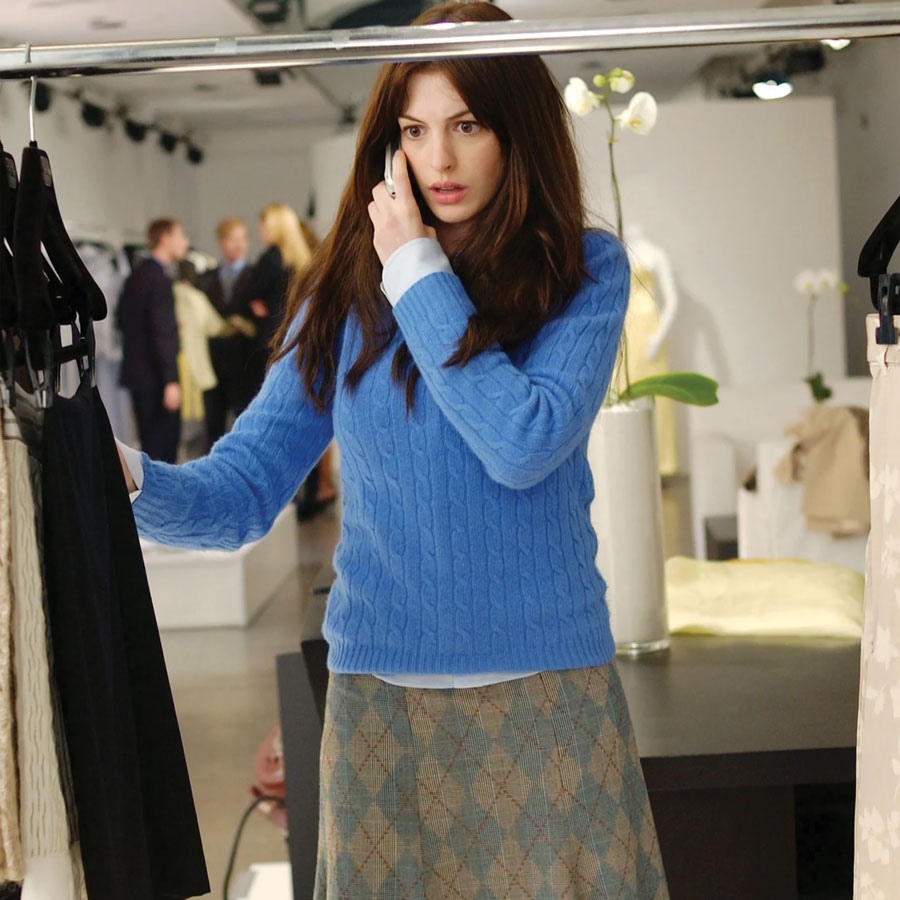Fashion Week and climate change not a great fit, says Holly Hughes…
In The Devil Wears Prada, Miranda Priestly, played by Meryl Streep, schools Anne Hathaway’s character on the trickle-down potency of fashion. The scene, in which Streep icily charts the evolution of the cerulean, not blue, sweater Hathaway is wearing, from Oscar de la Renta’s 2002 collection to the “department store clearance bin she fished it out from”, illustrates the omnipotent influence of fashion shows. The thesis is this: every sartorial choice we make – even when we feel we’re not making a choice at all – is intrinsically and unavoidably informed by the biannual catwalk shows of Fashion Week in London, New York, Paris and Milan, and to a lesser extent, shows in other big cities around the world.
We are quick to decry the enormous levels of waste, pollution, and social inequality that stem from the bottom of the fashion pyramid (namely, the bargain bin of fast fashion) but what is happening at the top? If designers set trends, isn’t it also their responsibility to be the leaders of fashion sustainability within the fashion world? How to reconcile a worsening climate emergency with the continuation of events that, at their core, are intrinsically at odds with protecting the planet? (A 2020 report found that the annual travel of designers and buyers to the four major Fashion Week locations generates 241,000 tonnes of emissions. That’s the annual carbon footprint of a small country. The fashion industry accounts for approximately ten per cent of global carbon emissions.)
Over the past few years, the environmental impact of Fashion Week has been of concern to organisers, designers, and campaigners alike. Sweden, to the shock of the fashion world, cancelled Stockholm Fashion Week in 2019 in an effort to address its environmental impact. It has since relaunched as a hybrid digital and in-person event.
In 2023, Copenhagen Fashion Week launched fashion’s first sustainability standards. These standards – which place a blanket ban on fur, require designs to use a minimum of 50 per cent recycled materials, and also forbid destroying unsold stock – are mandatory for designers wishing to show in Copenhagen. Their goal is to help brands transition to fully sustainable collections. Oslo and Helsinki, with their smaller Fashion Week events, have followed suit.
“If designers set trends, isn’t it also their responsibility to be the leaders of fashion sustainability within the fashion world?”
As Nanna and Simon Wick of Copenhagen brand (di)vision point out, “We know that we are contributing to an industry that is polluting way more than it should.” (di)vision and brands like it are trying to overcome this inevitable pollution in myriad ways, with many using the platform of Fashion Week to do so. Ciara Barry, policy and campaigns manager at the non-profit Fashion Revolution, which campaigns for a clean, safe, fair, transparent and accountable global fashion industry that conserves and restores the environment and values people over growth and profit, isn’t sure. “The Copenhagen Fashion Week requirements are absolutely better than nothing,” she said. “But all fashion shows should move forward by introducing sustainability standards that go further – they could really drive meaningful change in doing so.”
The truth is, major fashion weeks aren’t going far enough. Yes, Milan launched sustainability awards. New York established The Green Show last year – an event that showcases innovation in fashion sustainability. London encourages brands to join the UN’s Climate Challenge. Paris designers are favouring organic materials and natural processes. Offsetting has become a popular way to “neutralise” fashion shows without compromising on the private or business class air travel of workers and guests.
These feel like promising developments but are they transformative enough? Is this really adequate when, at time of writing, 2024 is set to be the hottest year on record? The opening of Milan Fashion Week AW24 – a city still recovering from hailstorms caused by global warming – was disrupted by a provocative installation featuring a car destroyed by these apocalyptic hailstones, with the words, ‘climate change does not exist’ written across its bonnet. London Fashion Week is overtaken annually by Extinction Rebellion activists and more than half of British consumers believe the event to be responsible for creating more fast fashion waste.
Stella McCartney’s AW24 Paris collection featured a voiceover from Mother Earth that asked: “Why are you harming me? What will be left of me, after you? I still love you, do you still love me? I need you to show it – it’s about f****** time.” The show was, according to McCartney, an indictment of fashion’s destructive processes and a glimpse of a brighter future – the collection it accompanied was made of 90 per cent responsible materials.
New York-based Uruguyan designer Gabriela Hearst’s SS20 runway show was the world’s first carbon-neutral fashion show. “If we don’t know our impact, we can’t reduce it,” Hearst said of her carbon-neutral ambition at the time. “I love what I do but I have to find ways that I’m not adding to the problem.” Hearst examined every aspect of her show’s production, design, and installation in order to reduce its carbon footprint, and she offset the remainder. Recycled wood and paper were used for set construction and invites; models already in New York were prioritised; caterers used local ingredients; the travel emissions of 1,000 guests and 900 workers were offset. The show was quickly followed by other carbon-neutral commitments, both on the runway and in supply chains, from the likes of Gucci and Burberry. After three years heading up French luxury house Chloé, Hearst is recommitting to her namesake label; her ambition is to build the slow-and-steady, sustainable fashion brand of the future.
While there is positive movement towards carbon-neutral shows, the leaps need to be bigger and they need to be faster. Fashion Week organisers have proposed combining collections for one season, integrating men’s and women’s shows into one event, establishing fashion districts to limit traffic congestion, and encourage sharing venue spaces for a smaller impact. To my mind – I must admit, not the mind of a fashion aficionado – this is the bare minimum for creating fashion weeks that really do practise what they preach.
Fashion Week, wherever it is held, sets the fashion agenda. It tells us what is in, what is not. While I am ambivalent about bringing morality into art, when it comes to the climate emergency, climate responsibility feels every bit as integral to a catwalk as cerulean was to Miranda Priestly’s pronouncement on the colour blue.











